I am sure that you have heard about Japandi Style If you don’t know what it is, don’t worry. I will fill you in on this stylish concept.
In this article, we will find what makes the Japandi Style unique, super cool, and comfy.
We will learn how it’s different from other styles and discover some cool tricks to make your room into a Japandi-inspired wonderland. So let’s dive into this together.
What Is Japandi Style?
It’s like a magical blend of two styles: one from Japan and another from Scandinavia (a country from Northern Europe).
Imagine if you combined the calm and peaceful filling of the Zen garden in Japan with the cozy and elegant vibes of a Scandinavian cabin in the woods. Yup, that’s Japandi style!
What Is The History Of Japandi Style?
It all started 150 years ago, in the late 19th century, when Danish artists started traveling to Japan seeking new inspiration.
They were among the first Westerners to visit the nation, and they fell in love with the craftsmanship, quality, and natural materials of the local artisans.
The movement is the foundation of Japan’s cultural ties.
In an interview with BBC, Danish designer Lars Vejen, who visited Japan in 1995, said, “Japan still has the most amazing, best-preserved craftsmanship and still honors traditions.
They’re perfectionists in so many ways. When I bring my designs to a Japanese client, there is the perfect match between the simple idea of form and the execution of the craftsmanship.”
What Are The Benefits Of The Japandi Style?
Adopting Japandi style in your home can bring numerous benefits.
- It follows a minimalistic approach, which helps to remove clutter and lower visual noise, which can lead to a more relaxing and mindful living space.
- It also uses natural materials and earthy colors, which can create a connection with nature and a soothing ambiance.
Japanese Style vs. Scandinavian Style
Japanese Style:
- Design Philosophy: focuses on Zen and Wabi-Sabi (celebrating imperfection and natural beauty)
- Color palette: earthy tones (shades of white, cream, brown, green, gray and beige)
- Materials: fine wood, bamboo, silk, rice straw mats (Tatami), paper
- Furniture: – Unornamented designs, natural elements, and low-lying furniture
- Lighting: soft, diffused light (natural light through translucent shoji screens)
Scandinavian Style:
- Design Philosophy: prioritizes “Hygge” (coziness and comfort)
- Color Palette: muted colors (forest green, burnt orange, dusty pink, and pastel blue)
- Materials: light and bright wood, linen, jute, burlap, wool
- Furniture: geometric shapes and clean lines
- Lighting: maximum natural light
Japandi Color Palette: Embracing Harmony in Design and Lifestyle
51 Japandi Dining Room Ideas, Inspiration And Photos
41 Japandi Bathroom Ideas, Inspiration And Design
51 Japandi Kitchen Ideas And Inspiration For Cooking Zen
What Are The Characteristics Of The Japandi Style?
Now, let’s talk about what makes Japandi style so special. It’s like a recipe with different ingredients that make it taste awesome. Here are the key elements:
i. Minimalism: Less is More:
Japandi is the art of keeping things simple. Imagine a room with just a few things, but they are necessary and cool.
It’s like a fresh start, so you can think and breathe better in your space.
ii. Natural Materials: Bringing Nature Inside:
Japandi Style loves nature. Things like wood, bamboo, stone, and cotton are used in decoration. It’s like bringing a piece of heart inside your home.
Natural materials not only make your space warm and cozy, but they also help you keep your mind healthy and relaxed.
iii. Neutral Colors—Peaceful Tones:
Picture a room with colors like soft grey, gentle whites, and maybe a little touch of muted pastels.
These are the colors Japandi likes. They make your space calm and peaceful, like a serene lake.
iv. Functional Furniture—Everything Has A Job:
In this style, we use furniture that is not just pretty but also useful. Like a chair that’s not only comfortable but also has a secret space.
Functional furniture helps you keep your space organized.
v. Light And Space: Let the Sunshine In:
There is the utmost importance of sunlight in this style. A large window that lets the sunshine fill your space. This makes your space feel open and welcoming.
So Japandi style is a mix of simplicity, nature, calm colors, functional furniture, and lots of natural light. It’s like creating a cozy and peaceful oasis in your home.
Material used in Japandi style are:
i. Japandi Furniture:
- Rattan
- Wicker
- Cane
- Wood (walnut, acorn, and teak)
- Bamboo
ii. Japandi Textiles:
- Organic Lines
- Organic Brushed Cotton
- Organic Cotton Muslin
- Velvet
iii. Japandi Decor:
- Terra Cotta
- Clay
- Glass
- Concrete
- Plants
- Wood
- Anything Handmade
How To Use Japandi Style In Your Interior Design?
Let’s get ready to turn your space into a Japandi masterpiece. Think of it as an exciting adventure where you get to design your own cozy and peaceful oasis.
i. Selecting The Perfect Color Palette: Painting The Serenity
Imagine you are a painter, and your canvas is your room. Fill your color palette with cozy and soothing colors, like neutrals, off-whites, and maybe some light pastels.
It’s like picking the color that makes a serene and calm environment around you. So, for the shades that make you feel relaxed and happy.
ii. Selecting Furniture And Decor: Treasure Hunt Time
When selecting Japandi furniture, focus on clean lines and minimal design.
Choose furniture crafted from natural materials like wood and bamboo, maintaining a light color palette to enhance the overall aesthetic appeal.
Look for pieces that can serve more than one purpose, such as tables that you can use for dining or working, or benches and ottomans that have storage space.
For a Japanese touch, go for low-lying angles and tatami platforms.
For the decor, mix traditional Japanese and Scandinavian elements to create balance.
Use Japanese items like kokeshi dolls, folding screens, and calligraphy scrolls to warm up and personalize the space.
Add a contemporary feel with modern elements like abstract art and colorful throw pillows.
Don’t clutter your space with too much furniture and décor; keep it to the minimum, since it’s an effort to create a serene environment.
iii. Embracing The Light—Let There Be Sunshine:
Natural light is like a warm hug from the sun. Open your curtains and let the sunshine in as much as you can.
Make sure your furniture and decor are perfectly arranged, and avoid using heavy curtains so they are not blocking the sun.
Use sheer curtains to let natural light flood in and low-wattage bulbs to create a cozy and welcoming ambiance.
iv. Decluttering The Space—Neat And Organised:
Jqapandi Design adores organized and clutter-free spaces. So, keep the space neat, and keep things simple and uncluttered.
Use shelves and clever storage solutions to tuck away things you don’t need.
v. Incorporating Nature Touch—Nature Inside:
Let nature put the final touch on your Japandi interior design. Use bonsai trees, houseplants, or aquariums to create a focal point and make the room more attractive.
For some contrast, put some fresh flowers or succulents in porcelain vases with geometric shapes.
Japandi Design Across Different Rooms
Now that you are getting the hang of this minimal style, it’s time to see how this magical style can work its charm in different rooms of your home.
It’s like discovering the many colors in your crayon box—each room has its unique Japandi touch.

i. Japandi Living Room: The Heart Of Comfort:
Imagine a Japandi living room, with a plush, soft gray sofa adorned with textured cushions.
A wooden coffee table sits gracefully in the center, perhaps with a handwoven tray for a touch of artistry.
Consider introducing low-maintenance indoor plants like a resilient snake plant or a cascading pothos, bringing nature’s serenity indoors.
A cozy throw blanket drapes casually over the arm of the sofa, inviting you to snuggle in during chilly evenings.

ii. Japandi Bedroom: Serene Dreams Await:
Your bedroom is your sanctuary for rest and rejuvenation. Embrace the Japandi approach by selecting a minimalist bed frame adorned with crisp, neutral bedding that exudes tranquility.
A soft, neutral color palette surrounds you, encouraging peaceful slumber. Keep decor minimal, with a wooden side table and perhaps a single, striking artwork.
A touch of nature can be added through a potted plant on your windowsill, bringing a breath of fresh air to your japandi bedroom.

iii. Japandi Kitchen: Functionality Meets Elegance:
The kitchen is where you create culinary masterpieces. In the Japandi kitchen, envision sleek, light wood cabinets with clean lines that maintain an organized look.
Utilize open shelving to showcase minimalist tableware, creating a harmonious blend of functionality and style.
A bamboo cutting board adds a natural touch, and a small indoor herb garden can thrive on your windowsill, offering fresh herbs for your culinary adventures.
Delve deeper into our exclusive “51 Japandi Kitchen Design Ideas” for inspiration that seamlessly merges style and functionality.

iv. Japandi Bathroom: A Spa Retreat At Home
Transform your bathroom into a spa-like heaven. Imagine soft, muted tiles that create a serene atmosphere, complemented by a wooden vanity with a sleek, minimalist design.
Fluffy white towels await your indulgence, evoking the luxury of a spa. Add a bamboo bath mat underfoot for a gentle, natural feel.
Discover our japandi bathroom design ideas on how to infuse your space with the timeless elegance of Japandi design.

v. Japandi Dining Room: Elegance In Simplicity
The dining room is where you share meals and stories with loved ones. Choose a wooden dining table that invites long conversations.
Minimalistic tableware in calming neutral hues sets the stage for elegant dining. Keep a vase of fresh flowers as a centerpiece, bringing a touch of nature to your dining experience.
Using Japandi design in these various rooms, your home becomes a symphony of elegance and comfort.
Each room tells its own story, but together, they create a soothing and harmonious narrative that is uniquely yours.
Real-Life Japandi Home Tour
We’ve gathered some real Japandi projects to inspire you. You’ll quickly see just how awesome it is to have Japandi style in your home.
Check out these projects to get a feel for how it looks, what homeowners think, and all the good stuff!
1. Notting Hill Townhouse Project, London
Designer: De Rosee Sa
Source: Homes And Gardens
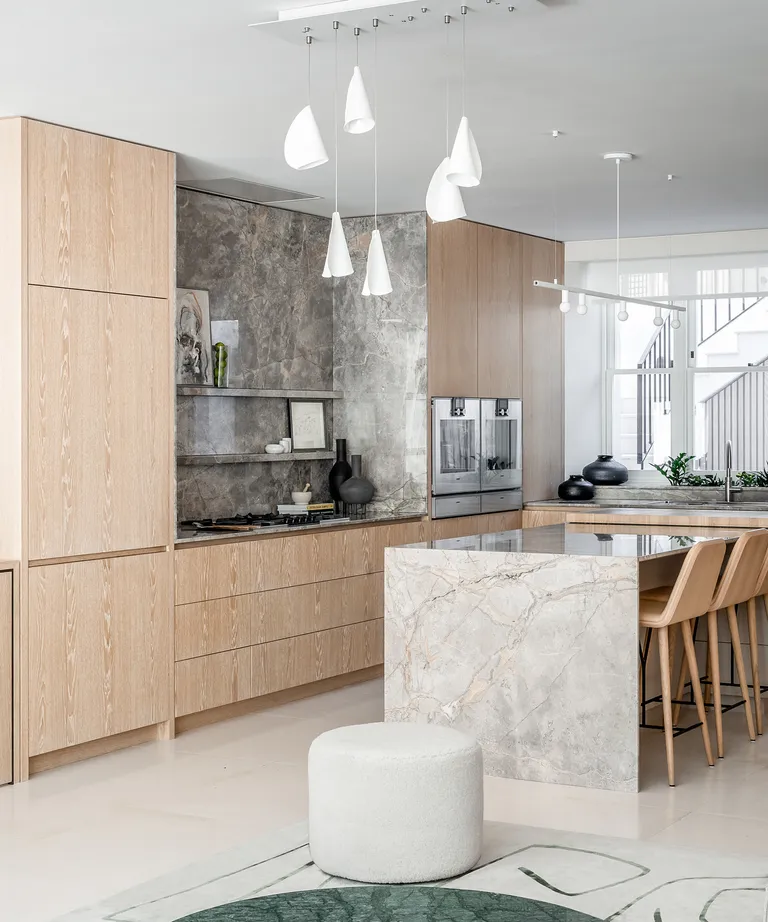
Kitchen
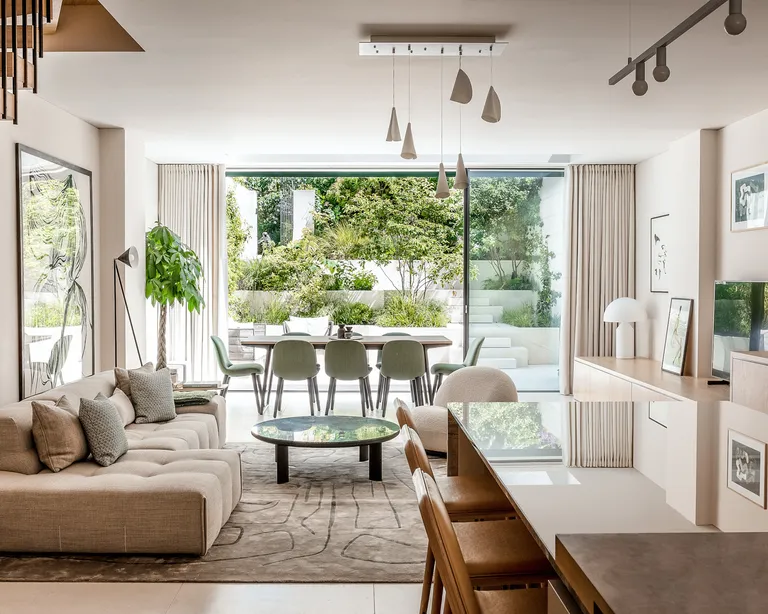
Open Living Space
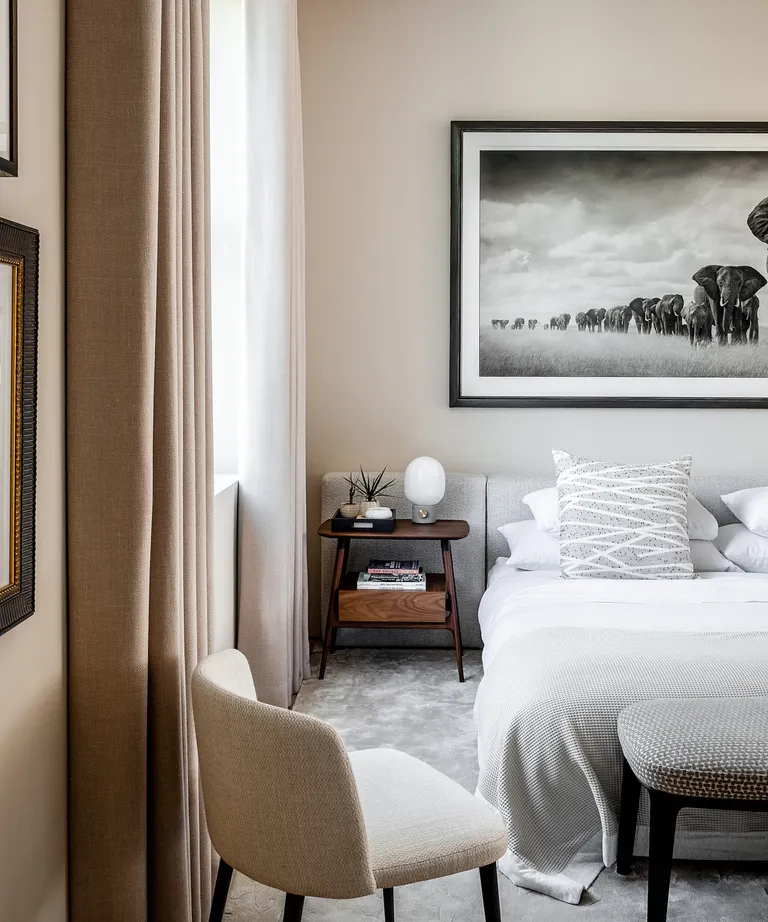
Main Bedroom
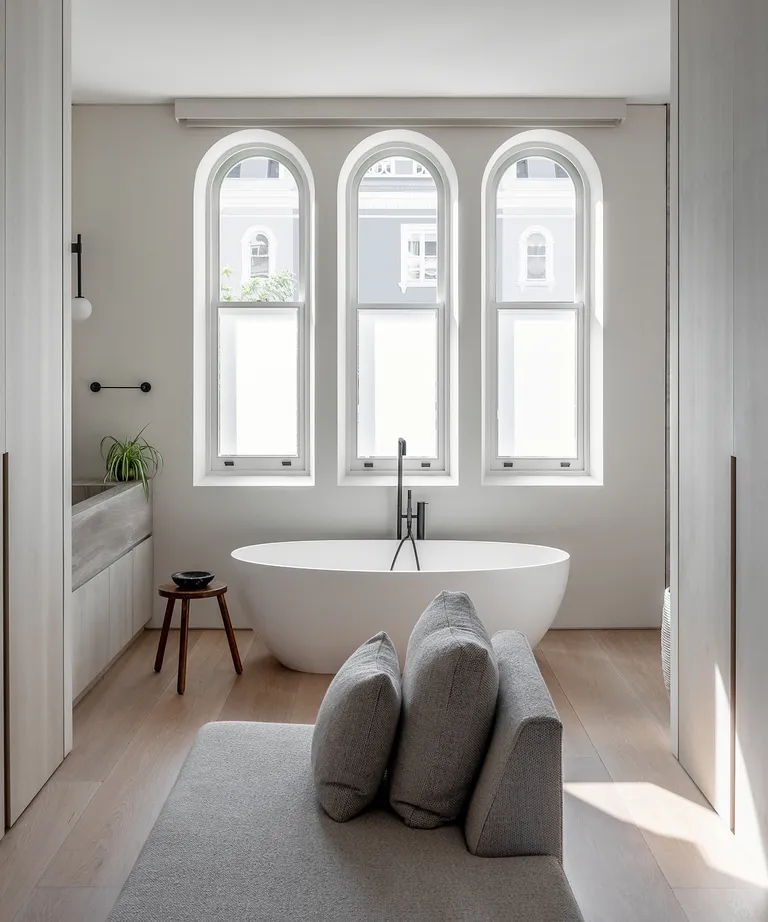
Ensuite
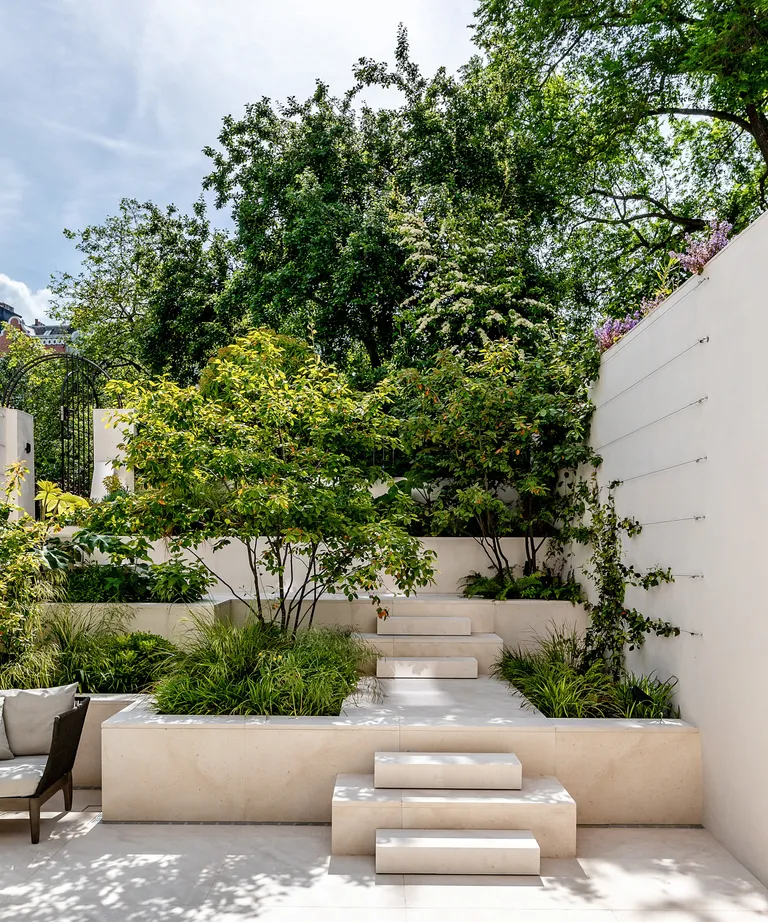
Outdoor
2. Wellington, New Zealand
Source: Your Home and Gardens

Living Room

Dining And Kitchen

Outdoor
Japandi DIY Projects: Infuse Your Personal Touch
Now get ready to roll up your sleeves and put your creativity to work. Japandi DIY projects are like crafting your very own pieces of art that blend seamlessly with your Japandi-inspired spaces.
i. Upcycling Furniture: Breath New Life
Have you ever thought about turning a worn-out piece of furniture into Japandi masterpiece?
Imagine giving a vintage wooden dresser a smooth, matte grey makeover. You are not only giving it new life but also infusing Japandi charm.
It’s like turning an old story into a modern tale.
Here are a few examples:
- Create a rustic yet modern coffee table by repurposing reclaimed wood
- Transform wooden pallets into minimalist dining tables or seating
- Combine two wooden ladders with wooden planks to create a functional bookshelf
- Reupholstering your old armchair with neutral fabric
- Use wooden shelving to form a custom storage unit.
- Craft a headboard from natural materials like bamboo or rattan
ii. Crafting Minimalist Decor: Personalised Simplicity
Express your unique style by creating minimalist decor items. How about some wall art with a neutral-toned canvas and easy geometric shapes?
Or, some pot with a sleek design, just for one flower you like. These personal, handmade touches make your space feel more homey and pretty.
Here are a few examples of minimalist decor that can be rewarding and creative for your Japandi home.
- Origami wall decor
- Clay vases
- Neutral-toned throw pillows
- Candle holders
- Wall hangings
- Paper lantern pendant lights
- Floating picture ledges
- Minimalist coasters
- Concrete planters, and
- Geometric wooden wall art
iii. Greening Your Space: Indoor Oasis
Bring nature indoors with DIY plant projects. Make your plant stands using wooden dowels or reclaimed materials. Create a hanging plant display using natural fibers like jute or macramé.
Here are some indoor plants that align beautifully with Japandi aesthetics.
- Snake Plant
- Fiddle Leaf Fig
- Bamboo Palm
- Bonsai Trees
- Japanese Maple and
- Air Plant
- Peace Lily
- Succulents
- ZZ Plant
Adding greenery enhances the Japandi vibe purifies the air and boosts your mood.
iv. Decluttering And Organizing—Zen-Inspired Harmony
Here comes the big part: staying organized and clutter-free. So start decluttering and getting rid of the things you don’t need in your home.
It’s giving your space a breath of fresh air. Consider building your custom storage solution or investing in stylish organizers that fit without interrupting Japandi aesthetics.
Here are ideas:
- Floating wall Shelves
- Woven Storage Baskets
- DIY Wooden Crates
- Minimalist Wall Hooks
- Hidden Storage Benches
- Custom Closet Organizers
- Under-Bed Storage Drawers
- Floating Bathroom Vanity
- Shoe Rack Bench
A tidy place not only looks beautiful but also feels peaceful.
v. Handcrafted Textiles – Cozy Comfort
Create your cozy textiles to add warmth to your Japandi space. Knit or crochet soft blankets and throw pillows in neutral colors.
These handmade textiles provide comfort, and carry the essence of your personal touch, making your space even more inviting.
Here are a few examples:
- Woven Wall Hangings – use natural fibers like cotton, jute or wool
- Hand-Print Throw Pillows – choose colors like soft grays, muted blues, or earthy tones
- Macrame Plant Hangers – using cord or rope
- Custom Table Linen – like tablecloths, placemats, and napkins using linen or cotton fabric
- Embroidered Artwork – featuring serene landscapes, minimalist geometric designs, or even Japanese characters
- Handwoven Rug – using natural materials like sisal or wool
How To Maintain The Japandi Style?
Creating a Japandi-inspired space is a labor the journey doesn’t end with the initial design.
To truly embody the essence of Japadi Style, It’s essential to embrace regular maintenance and decluttering.
This ongoing commitment is a testament to the harmony between elegance and simplicity.
i. Mindful Edititig:
Time-to-time review your decor and furnishing with discerning eyes. It’s not about removing everything but about mindful editing.
If you find that a piece no longer resonates with the Japandi style or your evolving tastes, consider repurposing or donating it.
This act of reflection and editing keeps your space in alignment with Japandi principles.
ii. Embracing Zen Habits:
Incorporate Zen-inspired habits into your daily routine. Take a few moments each day for mindful cleaning and tidying.
Return items to their places, fluff cushions, and wipe down surface. These small, regular acts of care ensure that your space remains a sanctuary of calm and order.
iii. Seasonal Refresh:
With the changing seasons, consider a seasonal refresh of your decor. Swap out textiles like throw pillows and blankets to reflect the time of year.
This is an opportunity to infuse subtle touches of color and texture into your space while still adhering to the Japandi color palette.
iv. Quality Over Quantity:
Japandi champions quality over quantity. When adding new items to your space, be deliberate in your choices.
Select pieces that resonate deeply with the Japandi ethos, whether it’s furniture made from sustainable materials or decor items that evoke a sense of tranquility.
Each addition should enhance the elegance and simplicity of your home.
v. The Emotional Landscape:
Remember that maintaining Japandi isn’t just about aesthetics; it’s also about nurturing your emotional landscape.
A clutter-free space can reduce stress and promote a sense of calm. By dedicating time to regular maintenance, you’re investing in your well-being.
vi. Celebrate The Journey:
Lastly, celebrate the journey of maintaining the Japandi Style. It’s an evolving process that reflects your growth and mindfulness.
Take pride in the serene and elegant living space you’ve cultivated, and let it continue to inspire you and those who share your home.
By embracing the practice of decluttering and ongoing maintenance, you ensure that your Japandi-inspired space remains a tranquil haven, a testament to the enduring beauty of simplicity and mindfulness in design.
Japandi Style vs. Other Styles
i. Japandi vs. Minimalism
- Minimalism Focus: Both prioritize simplicity, but minimalism is purely about decluttered spaces and bare essentials. Japandi Unique: Japandi adds warmth with natural materials, an earthy color palette, and an appreciation for imperfection (wabi-sabi).
- Japandi Focus: Japandi adds warmth with natural materials, an earthy color palette, and an appreciation (wabi-sabi).
ii. Japandi vs. Industrial
- Materials: Japandi emphasizes natural materials, while the industrial style features raw materials like metal and exposed brick.
- Color Palette: Japandi leans toward muted tones; industrial style often incorporates darker, edgier colors.
- Atmosphere: Japandi creates a serene, Zen-like ambiance, whereas the industrial style has an urban, factory-inspired feel.
iii. Japandi vs. Bohemian
- Aesthetics: Japandi is minimalistic and structured; Bohemian style is eclectic and free-spirited.
- Materials: Japandi prefers natural materials; the Bohemian style combines a variety of textures and patterns.
- Color Palette: Japandi uses a subdued palette; Bohemian style bursts with vibrant colors and patterns.
iv. Japandi vs. Mid-Century
- Era: Mid-century modern reflects the design aesthetics of the mid-20th century; Japandi is a contemporary fusion.
- Materials: Japandi includes more natural materials; mid-century modern uses materials like molded plastic and plywood.
- Furniture: Mid-century modern has iconic, retro pieces; Japandi leans towards simple, functional designs.
Remember that these comparisons offer a simplified overview. Each style has its unique charm and can be adapted to suit individual preferences and needs in interior design.

